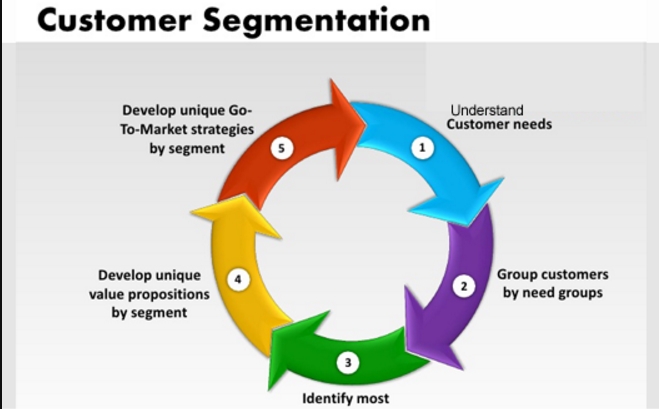Customer segmentation enables the ecommerce businesses to focus on particular customers groups in an efficient manner. Customers prefer to visit those ecommerce websites that are not just interactive but also provide the best customer experience. Companies have accumulated years of data to fully understand the customers and their interaction with the brand. In order to know what people need and want from your company, you have to combine customer demographic and behavioral data with the data of customer feedback.
Data is the most crucial part of online marketing and it can be simply accessed by knowing your customers on a personal level. It will show you their activities such as how they search for products, how they respond to campaigns and their browsing patterns. You can even know more about your product from those who are using it. This data and information, in turn, will assist you to present an enhanced, more targeted campaign. By simply using better data, you can provide better customer segmentation.
Here are the top 7 Essential Customer Segments for Your Ecommerce Website:
1. Personalized Data (Gender, Income, Style, Age etc.)
When a customer visits an ecommerce website, his/her information like the time spent, most visited pages, products etc. are being tracked. Then accordingly you can set up an SEO campaign to get more and more customers and retain the existing customers. Also, it’s vital that this experiment data must be seen from the viewpoint of these customer properties. Whether the data is captured and shown on your site in the form of cookies or window-level javascript objects, it is your sites’ responsibility to show it.
2. Source Type Personalized Data (Gender, Income, Style, Age etc.)
Know the places your customers are coming from so that you can decisively think about how much to expend to get these customers. You must understand the difference between the behavior of customers arriving from search engines as opposed to those of social media sites. PROS can help you identify your “Source Type” that distinguishes customers arriving from Campaigns, Search Engines, Referral, and Direct. However, if you want further advanced segmentation, you can develop a custom segment to further split the Source Types. For example, Google vs Yahoo vs. Bing for search or Facebook vs LinkedIn.
3. Device Types (Desktop, Mobile, Tablet)
Ecommerce businesses must focus on mobile devices because over a quarter of total web traffic comes from there. That is why it is crucial for businesses to know the behavior of the mobile customers. You must have visibility into how the mobile traffic is taking each one of your essential conversion metrics. Furthermore, to consider the tablets and desktop, you can also develop a custom segment because usually larger screen prompts a different customer behavior as compared to that of mobile phone traffic.
4. Location
In order to properly understand the differences in the behavior of your customers, you can segment the significant customer populations into crucial locations. You should follow the philosophy which is being followed by the brick-and-mortar retail companies, i.e. “going local.” Your primary decision must be to analyze which “local” markets you should target. It can be done with the help of Geolocation segmentation. You can also get help from the built-in custom segment conditions to identify customers by location.
5. Customer Tiers (Logged In vs. Guest Users, VIP Status, Repeat Shoppers vs. First-Time Customers)
There is a difference between the behavior of a loyal customer and that of a first-time customer. Thus, they should be treated accordingly. After you have seen their behavior on the following visits, you can respectively optimize the experience of every segment. In order to track this data, you can make the most out of a cookie or window level javascript object. Once you thoroughly analyze the particular cookie or window-level javascript object, you can develop the custom segment.
6. Top Purchasers (High Cart Value)
Apart from focusing on customers who have previously bought a product from you, it is important to concentrate on customers who hold the maximum value to you. It is estimated that the spending capacity of around 1% of your loyal customer base can be as much as the total of 50% customers. Being highly valuable, these customers deserve your time and you must optimize their user experience as much as you can.
After the customer has done with their shopping, you can incorporate logic on your Confirmation Page to note the value of the commodities bought. If it crosses a specified limit, then you must add them to a “Top Purchaser” segment.
7. Users that have (or have not) completed an order in the last 30 days
It is likely that a customer who did shopping from your website some time back can be motivated with a promotional code to buy some different commodity. However, if a customer bought something from your website will not be requiring a special promotion to purchase again because your product is already in their thoughts. After the customer has bought a particular product, you can add it to their “Recently Purchased” section and show the time when that product was ordered.
With the help of customer segmentation, you can classify your customers so that you can not just filter your results but also add personalization to the user experience.
Zahoor Bhat has over 10+ years of experience as an online editor and media manager. He has worked with major online news and content sites as a media manager. He is well versed with major content management systems and web platforms such as WordPress and social media networks including Facebook, Twitter, Youtube, Google Business, Yelp, Instagram & Linkedin. He is an expert in content creation, proofreading and finally making it live. Being a social media expert, he is able to make relations with social media influencers and make sure to generate leads and grow business via different social media platforms.





